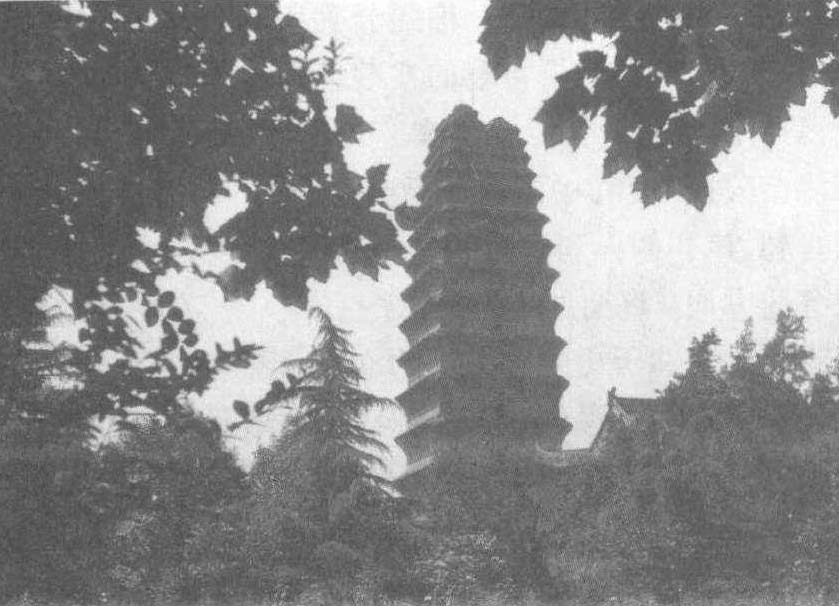小雁塔
见“荐福寺塔”。
小雁塔
小雁塔在西安市友谊路南侧荐福寺内,与东西相向的大雁塔相比显得略小而秀丽挺拔,故得此名。
荐福寺原址为唐太宗女儿襄阳公主的住宅。寺内有一口径3.30米,重万斤,于1192年(金明昌三年)铸成的巨大铁钟,钟声洪亮,“雁塔晨钟”成为关中八景之一。
现寺内707年(唐景龙元年)修建的小雁塔成为仅存的建筑。该寺塔原为15层,高45米。因地震原塔顶二层遭到破坏,现仅存13层,高43.30米,为密檐式方形砖构建筑。下有方形砖砌基座,每条长11米,塔身每层砖砌出檐,檐部次第迭砖,间以菱角牙子,檐上塔窗左右用涩砖砌成低矮的平座。每层南北各开一拱门。塔身宽度随塔高而递减。塔内为空简式结构,依木梯盘旋可上木制各楼层。
小雁塔造型秀丽挺拔,成为当时各地兴建砖石结构密檐塔所效仿。小雁塔与大雁塔共同组成了古都西安的著名寺塔景点,1961年3月国务院将小雁塔列入第一批全国重点文物保护单位。
地址:西安市友谊路 邮编:710006
电话:86-29-85253455
162 小雁塔
坐落于陕西西安荐福寺。寺建于唐文明元年(684),塔建于唐景龙元年(707)。因其较大雁塔体量小而得名。塔为砖筑,15层密檐式。因地震最上两层震坍,塔身开裂。现为13层,高约45米。平面为正方形,底层每边长11.38米。塔壁每层砖砌出檐,檐部迭涩砖,间以二层菱角牙子。塔身逐层内收,成卷杀轮廓,造型玲珑秀气,与大雁塔相映成辉。
小雁塔
唐代长安城内的著名佛塔,位于西安市友谊西路南侧,又称荐福寺塔,始建于唐中宗景龙年间(706~709年),成化二十三年地震使塔顶坠毁,塔身中裂,重修后仍保持原状,是唐代密檐式塔的代表作。塔以青砖砌成,共15层,现残高43.94m,塔身略呈和缓的卷杀曲线,形象挺拔秀丽,底层有券门,以上各层为券窗,门楣和门框布满唐代蔓草图案线刻,雕刻精细流畅,塔内设有木构楼层,有木梯盘旋而上,塔内有唐以后历代题刻多处,十分珍贵。
小雁塔
全国重点文物保护单位。位于友谊西路南侧荐福寺内。寺地原为隋炀帝杨广为晋王时的藩邸,唐初改为襄城公主宅第。公元684年,唐睿宗为追念高宗,于此建献福寺。武则天天授元年(690)改名荐福寺。唐代名僧义净于神龙二年(706)在此译经56部,并撰《大唐西域求法高僧传》。唐中宗于景龙元年(707)始建荐福寺塔。因塔体较大雁塔小,故称小雁塔。据碑文记载,寺屡遭兵燹,现存殿宇系明正统十四年(1449)重建。塔为密檐式方形砖构建筑。始建十五层,高约46米。后经明成化二十三年(1487)和嘉靖三十四年(1555)两次大地震,塔顶毁坏,今存十三层,残高43.94米,底层每边为11.38米。小雁塔为早期密檐式塔的代表作。结构上由于塔身小窗南北相对,上下成串,削弱了整体结构的牢固,因此在地震中曾中裂尺许,后再经地震,塔竟一夕如故,若似神合,但其裂缝仍在。1964年4月起大修,次年9月竣工,塔的二、五、七、九、十一各层加置暗藏钢箍各一道,既加固了塔身,又保持了古塔遭震裂痕原貌。塔身五层以下收分极小,六层以上塔身外形急剧收煞。荐福寺亦经修葺,寺内钟楼悬有巨大铁钟,高3.5米,口径2.5米,重约10吨。钟为金章宗明昌三年(1192)所铸,原置于武功县崇敬寺,康熙年间移入荐福寺。每当清晨撞钟,声彻城乡。“雁塔晨钟”为“关中八景”之一。清人朱集义题诗云:“噌吰初破晓来霜,落月迟迟满大荒。枕上一声残梦醒,千秋胜迹总苍茫。”
小雁塔
中国古塔。位于陕西省西安市南郊荐福寺内。寺址原为隋炀帝居藩时旧第,始建于武则天文明元年(684),初名献福寺,塔建于公元707年至710年,高15层,塔顶已毁。现高43 m,下为砖砌基座,平面呈方形。因比大雁塔小,故名小雁塔。塔平面为正方形,底层每面宽11.25 m,建在砖砌高台上,原有密檐15层,明嘉靖三十四年(1555)陕西大地震,顶部2层震倒,现余13层,塔室为正方形,南、北各开1门,其余各层壁面均设拱门。1000多年来,历经70余次地震。在1487年长安地震中,“自顶中至足中裂尺许”,后在1521年的地震中,竟被震合。这为研究地震史提供了宝贵资料。全国重点文物保护单位。
小雁塔
位于西安南门外友谊西路荐福寺内。创建于唐中宗景龙元年(707),共15层,高约45米,塔身由下向上,每一层皆依次收缩,愈上愈细小,为典型的密檐式砖塔。塔内设楼板旋梯,可攀登。外形秀丽玲珑,与慈恩寺大雁塔的雄伟气概互相辉映。因规模较小,故俗称小雁塔。1487年,陕西发生6级地震,小雁塔被震裂。时隔34年,即1521年,陕西再次发生地震,塔的裂缝竟然合拢,复原如初。群众认为这是佛神显灵,小雁塔才得以“神合”。后来有人把这件事刻在塔北门的门楣上,以彰神奇。明嘉靖三十四年(1555年),陕西华县发生8级地震,塔顶端两层被震塌。现余13层,残高43.3米。解放后修复小雁塔时,“神合”之迷才被解开。原来小雁塔的地基颇为独特,为夯筑成的半圆球体。这样的地基结构因重心高,基座小,故可均匀分散所应之力不容易倒塌。这种建筑结构完全符合“不倒翁”原理。小雁塔内有一口金代明昌三年(1192)铸的大铁钟。该钟口径近一丈,重两万余斤,是清康熙年间从武功县移入寺内的。钟声清脆悦耳,十里之外都能听到,人称“神钟”。据说如有人思念远方的亲人,只要把亲人的名字和去处写在一张黄笺贴到钟上,钟声就会把思念之情传到千里之外的亲人耳中。每日清晨,寺僧按时撞钟,钟声震撼全城。清代诗人朱集义题诗写道:“噌吰初破晓来霜,落月迟迟满大荒。枕上一声残梦醒,千秋胜迹总苍茫。”这就是著名的长安八景之一“雁塔晨钟”的生动写照。荐福寺山门面向正南,建筑群由北向南依次是藏经楼、小雁塔、大雄宝殿、“荐福寺堂图”和“重修荐福寺记”石碑四通、慈民阁、钟鼓楼。小雁塔为国家重点文物保护单位。

小雁塔
唐代长安城佛塔。因该塔原位于荐福寺的南院故又称“荐福寺塔”。现位于陕西省西安市南部。建于唐景龙元年(707年)。初为15层,现13层。明嘉靖三十四年(1555年)陕西大地震时,塔身被震裂,塔顶被毁坏。中华人民共和国成立后,于1964年进行修整加固,并发掘了塔基。塔的平面为方形,底层边长11.38米,塔残高43.3米,其每层高、宽度由下至上逐层递减,呈现自然缓和的锥状。地面以下有40米见方的夯筑地基,地基上有砖砌高台,塔身为砖造单筒式结构。底层南北各开1门,其上每层南北两面中央各开1券窗。塔外观为密檐式,每层塔身之上原有叠涩出檐15层,整体轮廓呈秀丽的券杀曲线。据记载,塔顶原有宝顶,惜已无存。该塔是唐代方形密檐空腔式砖塔的力作,1961年被国务院确定为全国重点文物保护单位。